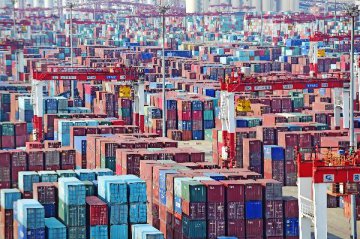
Since China proposed the Belt and Road Initiative in 2013, the country has quickened the paceto cooperate with economies along the Belt and Road routes.
In the past three years, countries and regions along the routes have become the new focus of China's outbound investments.
The World Investment Report 2016 released by the United Nations Conference on Trade and Development (UNCTAD) shows that China's outbound investment in 2015 grew 4 percent year on year to be 127.6 billion U.S. dollars, continuously ranking the third globally.
The country's outbound investment stock has already exceeded 1 trillion U.S dollars, ranking the tenth in the world.
With the rapid growth in the outbound investment, China's investment cooperation with the economies along the routes has demonstrated four major characteristics. First, the investment facilitation has been constantly strengthened.
In the past three years, China and countries along the routes have been dedicated to promoting investment facilitation and strengthening negotiations about bilateral investment protection agreements and agreements on avoidance of double taxation to gradually remove investment barriers and build a good business environment, which effectively promote the two-way investments between China and countries along the routes.
By June 30, 2016, China has signed the bilateral investment agreements with 104 countries and built the joint economic and trade commission mechanism and the mechanism of promoting investments and cooperation, which offered legal and institutional guarantees for mutual investments and cooperation of the two sides' enterprises.
By June 30, 2016, China has inked the tax treaties with 53 countries along the routes and initially built a tax treaty network covering major investment sources and outbound investment destinations, which reinforced the function of avoidance of double taxation.
In addition, the Chinese authorities have streamlined administration and rolled out facilitation measures.
Since the Ministry of Commerce (MOC) released the management methods of outbound investment, by September 8, 2016, the MOC and local commerce departments have put on records and approved 21,175 outbound investment deals, of which only 110 deals were carried out by the review and approval mechanism, accounting for 0.5 percent of the total and the remaining 99.5 percent deals were carried out by the filing system, making domestic enterprises' going global easier and more convenient, said Zhang Xiangchen, Deputy China International Trade Representative.
Second, Chinese enterprises' M As overseas pick up steam in recent years. From the introduction of the Belt and Road Initiative to July this year, China's investments in countries along the routes had amounted to 51.1 billion U.S. dollars accumulatively, accounting for 12 percent of the outbound direct investment in the period. It signed 12,500 project contracts worth 279 billion U.S. dollars with them in the period.
Under the large-scale overseas M A wave, China has become a major source of foreign capital for some developed countries. It is expected to continuously maintain a high-speed growth in the investments in developing countries in coming years, with the advancement in the Belt and Road Initiative and international capacity cooperation, said James Zhan, director of Investment and Enterprise at the UNCTAD.
According to China's outbound direct investment statistical report in 2015, the Chinese enterprises launched 101 M A transactions worth 9.23 billion U.S. dollars in the countries along the routes, accounting for 17 percent of the Chinese enterprises' outbound M A transactions in 2015. To be specific, the Chinese enterprises' M A investments exceeded 1 billion U.S. dollars in countries including Israel, Kazakhstan, Singapore, Russia and Laos.
Third, Chinese enterprises' outbound investments in industry and structure tend to be optimized. China has shifted its investments in countries along the routes to technology and capital sectors, like high-end manufacturing, IT, and medicine and health gradually from the previous energy and materials industries.
In addition, China's outbound investments focused mainly on developing countries previously. In the future, the outbound investments will go to manufacturing and even high-end technological industries in developed economies, said experts.
The "Belt and Road" Initiative is China's third opening-up. Unlike the previous construction of special economic zones and its accession to the WTO, the ongoing "Belt and Road" is to help China's funds, technologies and management go global with the opening-up in higher degree, more extensive range and higher level, said Wei Jianguo, vice president of the China Center for International Economic Exchanges (CCIEE).
Fourth, political risks and other factors restrict global layout of the Chinese enterprises. In recent years, government defaults and non-traditional security risks have become main risks of the Chinese enterprises' outbound investments.
According to the global investment risk analysis report released by the Sinosure, outbound investment risk of the Chinese enterprises has showed the diversified and complicated trend.
In addition, in the rapid expansion overseas, the Chinese enterprises have to further strengthen understanding and prediction of overseas M A risks.
Some enterprises lacked sufficient argument in the acquisition projects, bringing safety lapses to their future development. A few enterprises rely heavily on bank loans or investment funds in the overseas M A transactions and expose themselves to high-leverage risk, said Zhang Xiangchen.




















Latest comments